
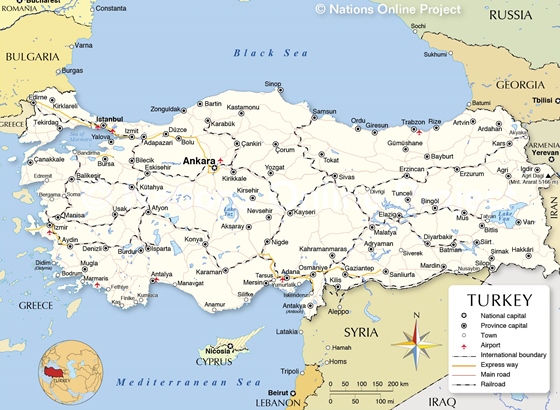
Map © Nations Online Project (info) | |
| Republic of Türkiye Capital Area Population Languages Currency |
Ankara 783 356 km2 84 600 000 Turkish Lira (TL or TRY) In 2023 a US Dollar was worth about 25 Lira |
Most of Turkey (correctly called the Republic of Türkiye) is in Anatolia in Western Asia, but there is also a small portion in the Balkans in Southern Europe, making it one of the very few countries in the world that straddles two continents. Türkiye has extensive coastlines on the Black Sea to the north, the Mediterranean Sea to the south and the Aegean Sea to the west, and shares borders with Georgia, Armenia, Azerbaijan, Iran, Iraq, Syria, Greece and Bulgaria. The majority of the population is Muslim but the government is a secular constitutional republic, established in 1923 after a War of Independence (1919-1923) that began in the aftermath of the First World War. | |
If you enjoyed reading this, please send me an email. All correspondence is appreciated!
[Monday 5 June 2023 : Cape Town, South Africa] The overnight Turkish Airlines flight deposited us in Istanbul at 5 am, refreshed and raring to go after a four year Covid-enforced travel hiatus. It was one of the most pleasant long-haul journeys I've ever experienced - no stops, no layovers, no gritty eyelids while sitting in some transit lounge at 1 am, just one long ride north over Africa to this ancient city that straddles Europe and Asia. Top Gun: Maverick, Tom Cruise's follow-up movie to his 1986 epic Top Gun, held my attention for part of the night. I didn't get to the end of the movie though; I'll have to finish it on the return flight in four weeks' time. The sequel was made no less than 36 years after the original, yet Tom Cruise still looks as young as he ever did! How is that possible?
[Tuesday 6 June : Istanbul, Türkiye] We had decided to explore Istanbul at the end of our trip rather than at the beginning. So instead of going in to the city from the airport we headed straight through to Domestic departures for our flight to Antalya on the Mediterranean coast. That meant Immigration first (quick and easy), baggage reclaim (our bags were the first off, incredibly), Customs (straight through the green line, no eye contact, no hesitation) and a large cash withdrawal of Turkish Lira from an ATM. We were congraulating ourselves on our good fortune, but then (of course) it all went pear-shaped. We had to check in for the flight to Antalya, and for this Turkish Airlines have introduced an unmanned self check-in system, which worked well up to the point where I had to load my backpack onto the weighing station. I had attached the luggage label with the bar code facing up so that it could be scanned, but the infernal device simply shuddered back and forth a few times then gave up with the message "error loading luggage." I tried again but the second time the machine wouldn't print a luggage label - obviously it knew that it had already printed one for my boarding pass. And the net result was the same, "error." We changed tack and loaded Karen's bag, and that worked perfectly. So my backpack was the problem.
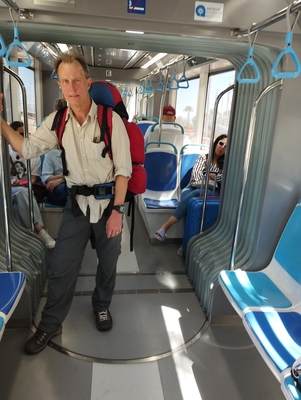
I went off in search of help. A young Turkish Airlines staff member came over and also tried to put my backpack on the plane. Same result. "Oversized bag," he announced confidently, despite the fact that my backpack was a good deal smaller than some of the monster wheelie suitcases I saw other people loading up. "Give me your boading pass." I handed it over, assuming he was going off to fix things up. We waited, and waited, and waited for him to return, but he didn't. Eventually we started to get concerned. I found another, different Turkish Airlines staff member and tried to explain what had happened. Between my almost non-existent Turkish and her broken English this did not go well. In the midst of my ever-growing frustration at my inability to elucidate the problem clearly and her inability to understand me, Karen came over. "I've got our boarding pass," she said. "That guy had to cancel your luggage label. Now we have to go to counter 41 to check in manually."
We trekked round to counter 41. The girl there was nonplussed at what had happened. She issued a new luggage label and affixed it to my bag, but instead of pushing my bag through to the carousel behind her, she got up from behind the counter and walked back towards the self check-in desks, "Follow me," she said. Now what? We traipsed after her to counter 21, which was unmanned. The girl looked around in consternation, then went to a door marked "Staff Only," knocked and poked her head inside. After a brief conversation a young man appeared, wiping crumbs from his pimply jaw. He went to a large carousal and pointed. "Put bag in."
By now I was thoroughly browned off. "Antalya?" I asked. The youth nodded and pointed again. So I heaved my bag onto the carousel and it disappeared into the maw of Turkish Airlines' baggage handling system. I'll never see that bag again, I thought morosely. But what else could I do? When I turned round both the youth and the check-in girl had similarly disappeared. But at least we had boarding passes and our bags were checked in. We wandered off and sat at a ludicrously overpriced coffee place, watching the smorgasbord of nationalities walking past. A couple near us were talking Russian, which made me wonder what would happen if a Ukrainian was seated next to a Russian on an international flight from Istanbul. Fisticuffs in the cabin?
[Tuesday 6 June : Antalya] A couple of hours later we emerged into the balmy sunshine of early summer in southern Türkiye. Both our bags had made it to Antalya, so I must formally apologise to Turkish Airlines for ever doubting them. The plane had banked over the Mediterranean Sea before it landed in Antalya, the azure water calm and inviting at 10 am. The icy cold and relentless rain of Cape Town in June was forgotten as we followed the signs from the airport towards the tramway. The tram was elevated, and from the platform we could just about glimpse the sea beyond some industrial buildings. The tram was the easiest way to get from the airport into Antalya's city centre.
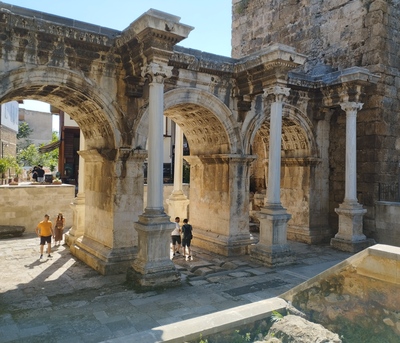
The next problem was buying tickets for the tram. The automated machine gave us two options - buy a reusable tram card or top up an existing card. No single-use tickets on public transport systems in this age of high technology, nor any humans to sell them to you ... We pressed "Buy Card" (luckily it was labelled in both English and Turkish) and were presented with the message "Cannot issue new cards now. Try again later." What? Later was no use; we needed a new card now. But if it couldn't issue a new card how were we going to ride the tram? Entrance was barred by an automated turnstile and card scanner.
A security guard standing nearby saw us struggling and came over. "You have visa?" he asked. I assumed he meant a credit card, not a document giving you permission to enter a foreign country, and nodded. "Machine take visa. No need card." He went with us to the turnstile and showed us the scanner on top. "Just tap card there." He pointed to the familiar-looking electronic chip scanner that I'd used thousands of times in shops and restaurants. I held my card over the scanner, the machine bleaped and displayed "TL 9.85," and then the turnstile opened. I walked through and repeated the process for Karen.
"Wow, that is clever," I said. "If you're a regular commuter you buy a reusable card which is probably cheaper per ride, but for one-off users like us you can just swipe your credit card. I'm impressed. Somebody thought this through." And it was cheap - just under 10 Turkish Lira translated to about 8 SA Rands.
A train was waiting right there and we climbed aboard. There was no doubt which direction we should go because the airport was the final stop on line T1. A minute later it moved, smoothly and quietly. Public transport sure has come on in leaps and bounds since the days of screeching, lurching behemoths belching smoke and fumes.
We had planned on checking into our hotel and then sorting out bus tickets for the 200 kilometre ride to Fethiye. Instead we just stayed on the tram all the way to the bus station (otogar), got off there and bought tickets on the 11 am bus to Fethiye the next day. Then we took the tram back to the city centre and got off at the Ismetpasa stop. Hotel Twenty, where we'd booked a room, was only a couple of hundred metres away, but finding it took the better part of an hour. In our jet-lagged, sleep-deprived state we managed to get the maps (paper and digital) so badly wrong that we walked in completely the wrong direction. After fifteen minutes of blundering around in streets that twisted and turned in more ways than Fred Astaire on steroids, a friendly Turk in a landrover offered to help. He hadn't heard of Hotel Twenty but looked it up on his phone. "It is close," he said, pointing at Google maps. "Five minutes." He was about to say more when a loud hoot interrupted him. He was blocking the narrow lane we were in, and an angry-looking youth driving dad's BMW could not get past. The man helping me had to drive off to allow Mr Self-Entitled to proceed.
"Close" turned out to be a misnomer. Half an hour later, after asking multiple people and finding ourselves ever more confused in the labyrinth of streets, a restaurant tout took us through his establishment, out the back door and pointed up the road. "Hotel Twenty is just there." And indeed it was. We were mightily relieved to check into a spotlessly clean, albeit rather cramped room.
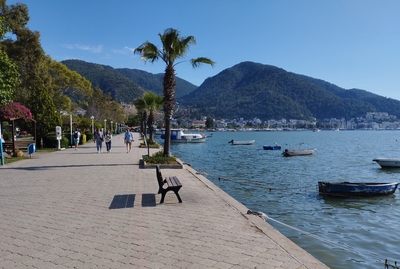
[Wednesday 7 June : Fethiye] The day started off on a fantastic note. A coffee place called Veysel Efendi Kahvecisi had caught my eye during our ramblings around Antalya the previous day, and at 8 am we were there. Thankfully it was open, unlike all the shops and offices around it; much like Spain and Italy, things seem to start late in Türkiye. We weren't quite ready to try Turkish coffee, so I had an Americano, Karen had an espresso and we shared a slice of apple pie. The coffee was absolutely superb, as was the apple pie. We headed off to the bus station rejuvenated and revived.
The bus trip to Fethiye took three and half hours. If that seems slow for a mere 200 kilometres, you're right ... but the speed limits on Turkish open roads are very low (never more than 90 km/h, often 70 km/h and sometimes only 50 km/h) and Turkish drivers seem to be careful and law-abiding. So we inched towards Fethiye on a beautiful two-lane separated highway. But it was no problem, because the scenery was varied and interesting - thick stands of Pine, Juniper and Olive trees, open grassland, cultivated fields and winding valleys between steep mountains. A toilet stop halfway to Fethiye gave me the opportunity to try some Turkish coffee for the first time. It was thick and strong (as I expected), but it also had an odd spicy taste which wasn't to my liking at all. I like my coffee to taste like COFFEE. Not cardamom or any other weird additive.
At Fethiye bus station we made sure we didn't repeat the mistakes we'd made in Antalya. We checked Google maps, the paper map and my compass before setting off, and this time we arrived at our hotel in ten minutes with no wrong turns. Our room at the Sunrise City Hotel turned out be a mini apartment, complete with lounge, bedroom and kitchen. We revelled in the unaccustomed space.
A kebab joint down a side road provided us with a late lunch. This place had no menu and only sold one item - chicken wraps for 35 Lira. The proprietor, who was alo the cook, was a toothless, unshaven fellow who cheerfully prepared our wraps with a lighted cigarette dangling from his mouth, the "No smoking" sign on a nearby pillar clearly of no consequence to him. But the wraps were lip-smackingly delicious, further confirmation that the best meals are to be found in nondescript restaurants on the back streets, catering to locals rather than tourists.
An afternoon stroll down to Fethiye's promenade and marina resulted in an unexpected treat. A small river flows through Fethiye into the sea at the marina, and at the point where the two meet we saw several giant turtles in the water. They seemed to be feeding on the detritus that was being swept into the sea, because they were stationed at the river mouth with their beaks wide open. Every few minutes they'd float to the surface, gulp in some air then go back down again. But not very deep, only about a metre or two. So we could see them clearly and they were enormous - one big one must have been close to a metre in length.
[Thursday 8 June : Ovacik] A huge (and limitless breakfast) at the Sunrise City Hotel fueled us for our first walking day of the trip. We planned to walk to Kayaköy, an abandoned former Greek town about 8 kilometres away, and from there on to Ovacik. Ovacik, a suburb of the beach resort town of Ölüdeniz, was where the Lycian Way trail officially started.
A few kilometres of confusing city streets brought us to a traffic circle at the bottom of a formidable-looking hill. "Kayaköy 5 km" proclaimed a sign, pointing up the hill. And so we started climbing, and climbing, and climbing. And still more climbing. The road zig-zagged this way and that, the turns sharp and brutal. Cars came past in low gear, their engines labouring. Our engines were labouring too. Finally we reached the summit, where I saw a sign saying "Fethiye 4 km." So, if Kayaköy was 5 kilometres away and we'd walked 4 kilometres from Fethiye, it had to be only one kilometre to go, right? You would think so ... except the alleged one kilometre took us 45 minutes to walk, and that was downhill! I can normally walk a kilometre in 10 minutes, but we were carrying backpacks and wearing boots, so perhaps it should have taken 15 minutes, or even 20 minutes. But not 45 minutes. This was our first introduction to what came to be known as "Turkish kilometres," as applied by the Turkish Roads Department and other organizations that measure distances in this country. We learned that all distance signs had to be multiplied by at least a factor of 33%, and often as much as 50%.
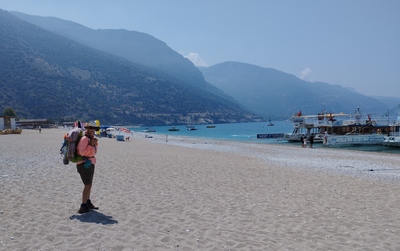
I expected Kayaköy to consist solely of empty and dilapidated stone houses, but in fact it was full of modern buildings and half-finished constructions. This was the modern part of Kayaköy, built in the valley below the abandoned former Greek settlement. We dived into the first restaurant we came to, a pleasant place with tables outside under the trees ... where we were subjected to a coffee and tea ripoff, Turkish-style. There was no menu, so we asked for tea and instant coffee (no espresso here). When I paid the bill I was shocked to see that tea cost 35 Lira (it was normally about 10 Lira) and INSTANT COFFEE cost the astronomical amount of 70 Lira! What? The coffee powder was 35 Lira and the hot milk was 35 Lira (about 30 SA Rand each). Lesson learnt - if there's no menu, always ask for the price first.
The new town of Kayaköy was so spread out it took ages to walk through it and find the abandoned village. It is now an open-air museum that you have to pay to enter, but it was still fascinating to wander about amongst stone houses that have been vacant for 100 years. I could see why no Turks wanted to move in - the village was on a rugged, stony slope that looked impossible to cultivate.
The last section of the walk to Ovacik was alongside a busy road in the baking sun. It wasn't obvious how far it was, because all the signs were for Ölüdeniz, the hugely popular beach resort further down the road. But for once we arrived sooner than we expected, and strolled into a ghastly hellhole of streets lined with bars, discos, restaurants and touts, all overlaid by loud and constant thumping rock music. Ovacik was the modern Türkiye, devoted to Western-style parties, drunken revelry, package tourists and prices in Pounds Sterling or Euros. Finding somewhere to stay took a bit of searching, but eventually we moved into a fetid little chamber in a place called Suzanne's Hotel. Suzanne herself checked us in, her faded and weary features a perfect match for the crumbling elegance of the establishment that bore her name.
For supper we succeeded in finding a reasonably quiet restaurant down a side street. Alfresco Dining, as its name implied, had an open courtyard filled with tables and obsequeous waiters. We chose one of the former and were fawned over by two of the latter. Everything about the place was classy and stylish (including the prices), but the menu only contained Western dishes; not a single Turkish option was available. The food came and was exquisitely presented, but it was mediocre and there wasn't much of it - the old "dull, overpriced food at ostentatious restaurants" syndrome. We reminded ourselves once again that eating at local restaurants serving local food was the way to go.

[Friday 9 June : Ovacik] After only one day of walking we decided to take a rest day ... or, at least, a half day. So we beetled the five kilometres down the steep hill to the beach resort of Ölüdeniz with a vague plan of staying there the night. What greeted us was a scaled-down version of Ovacik - beach bars, thumping music, party boats moored a few metres from the beach and acres of plastic loungers arrayed in neat rows. Several ocean-going yachts were moored off-shore. Paragliders were looping around in the air above, and every now and then one would land on the beach. Loads of Western tourists were dotted around on the beach and on loungers, drinking cocktails and getting slow-roasted in the sun. You could almost smell the sizzle of scorched flesh.
We trudged along the beach until we found a section beyond the loungers that seemed to be open to the riff-raff (meaning the non-paying public like us). It was so hot we stripped down to our swimming gear and headed for the water without hesitation. Getting in was harder than it looked - the beach was stony, uneven and hard on the feet of two hikers who'd been stomping around the countryside in heavy boots. There were no waves to speak of, just a gentle swell. And the water was WARM. We dived in and enjoyed a long swim in the Mediterranean. At 10 am the music was cranked up aboard several boats nearby that were rigged up in Pirates of the Caribbean fashion, and loud voices amplified by massive PA systems exhorted the revellers on board to start partying. Cheering, shouting and party noise followed. This went on for about an hour, at which time the boats moved away from the beach and headed out into the bay. At least it was quieter once they'd gone. One wonders how many drunken tourists they lose overboard every day.
Bored with swimming, we pondered our options. The hotels in Ölüdeniz were huge, package tourist-type places. The official start of the Lycian Way was at the top of the hill, very near Ovacik, so it seemed to make sense to head back there for the night. We could find a hotel near the start and hit the trail early. Walking back up the hill would be a brutal slog, but luckily there was another option - a regular minibus service (dolmus in Turkish) plied the route between Ölüdeniz and Ovacik. The dolmus station was at the bottom of the road up to Ovacik, so we simply climbed into the next one that was leaving and were back in Ovacik ten minutes later. We avoided Suzanne's Hotel like the plague and found a far nicer room at Mavi Yaprak Hotel, only a couple of hundred metres from the turnoff to the Lycian Way.
On the way down to Ölüdeniz we'd walked past the lower terminus of the spanking new cableway up Babadag Mountain (called Mount Anticragus in ancient times). That looked like a fun way to spend the afternoon, so after we'd checked into our hotel we strolled back there again and bought tickets. The cableway wasn't quite finished yet - only the lower three sections (of four) were complete. We rode up two different cable cars then sat in a chair lift for the last bit to the highest point that was operational (1700 metres above sea level). The final section, up to the summit of Babadag at 1969 metres, was still being constructed. The views were incredible. At the 1400 metre point, where the second cable car terminates, there is concrete take-off area for paragliders. We watched several of them run down the slope and jump off the edge, then soar into the air on the thermal air currents surrounding the mountain.
Supper was a tapas-style meal at a local eatery - olives (of course), chick peas, potatoes, köfte (meatballs, a very popular dish in Türkiye), mushrooms, green peppers and salad (with unlimited bread, something that seems to be the norm in Türkiye). It was twice as good and half the price of the classy place we'd visited the night before.
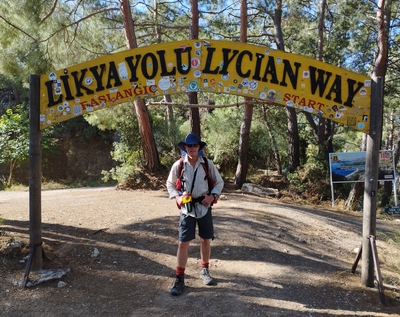

[Saturday 10 June : Faralya] We were back on the trail again after our brief rest in Ölüdeniz. In fact, today was our first day on the Lycian Way itself, because the trail officially starts near Ovacik. The walk we'd done from Fethiye to Ovacik was a sort of preamble to the main trek.The turnoff to the trailhead was a few hundred metres from our hotel, and by 9:30 am we were taking pictures of ourselves under the "Likya Yolu" sign. Then it was up, and up, and up as we ascended from sea level on the slopes of Babadag Mountain. The views back towards Ölüdeniz were stupendous. Along the way we only saw three other hikers - a lone Spaniard in his 20's and two older Americans. Pine, juniper and olive trees abounded as we turned and twisted our way upwards on a stony track.
Near the village of Kirme we passed some monstrous new houses under construction. Or perhaps they'd been started and abandoned - there was no evidence of any work taking place. A sign advertising Halil's Cafe kept our hopes up as the hours wore on, but poor Halil never got our custom because we came across another place called Cesme Basi Cafe first. This small local eatery was run by a family of four - a father who cooked food on an open fire, a mother who prepared dishes in the kitchen and two smiling young daughters who were waitresses. Tea, instant coffee (the only kind available) and a sandwich fueled us for the last hot stretch to Kirme.
Kirme was a diappointment. Everywhere we saw houses being built, but of hotels there was no sign. A noticeboard advertising Ayavindi Boutique Hotel got our hopes up, but the place must have been very (very) boutique because we never found it. One surly and unpleasant shopkeeper said "No hotels here. In Faralya. Four kilometres" when we asked about somewhere to stay in Kirme (Faralya, a much bigger place than Kirme, was the next town on the trail). There was nothing for it but to keep going, on legs already weary from miles of walking.
More than an hour later the tiled roofs of Faralya came into view. We passed the ostentatious Waterfall Mill Hotel and found a room at Gül Pansiyon, a modest inn run by an elderly woman and her husband. The balcony outside our room looked over a deep ravine that fell spectacularly down to the blue water of the Mediterranean. It was a fine end to a long and tiring day.
[Sunday 11 June : Kabak] We had last trekked in 2018 when we did the Camino in Spain, so we were five years older ... and the Camino was easy in comparison with the Lycian Way. Which meant we had sore legs before we even set out from Faralya. A steep ascent up to a jeep track left us sodden with perspiration and determined to stop for the night much earlier than the previous day. Our luck was in, because we reached the town of Kabak just after 12 noon. Kabak was high up the side of a slope above a small but exquisite beach. There were accommodation options in town as well as down at the beach.
"Can you manage another couple of kilometres?" I asked Karen. "It's not far down to the beach, but very, very steep according to the app." [Aside: We were using the TrailSmart cellphone app to help navigate the Lycian Way's often-confusing paths, and it was proving both accurate and helpful]
Karen grimaced. "No. I can't walk another inch. We have to stay here."
A minute later, right in the centre of Kabak, we spied a sign for Casa de Pietra Boutique Hotel. An Italian hotel? In Kabak in Türkiye? We went in, were shown a spacious room overlooking the sea, and took it immediately. The place was both luxurious and neglected, confirmation that it was indeed Italian. The fittings were immaculate, but quite a few light bulbs didn't work. The shower and bathroom were elegantly-designed, but there was no toilet paper. Still, these were minor issues that didn't worry us a jot.
Things got even better an hour later. Directly across the road from the hotel was a restaurant called Deniz Cafe. The street side of the place was completely open, and we observed many locals going in and out. We went there to try Turkish gözleme (pancakes, advertised on every menu we'd seen) and had a lip-smackingly delicious meal. I had a potato and cheese pancake, and Karen had one with mushrooms and cheese. Both came with an array of olives, pickles, tomatoes and cucumber. We thought the pancakes would simply be a late (and light) lunch, but we were so full afterwards that all we had for supper was an apple each.
[Monday 12 June : Kabak Beach] The endless steep ascents and descents had taken their toll on us. After all, this was supposed to be a holiday ... so we decided a rest day was in order, despite only having walked for three days. We simply had breakfast in Kabak town and walked the two kilometres down to Kabak Beach. And there we found a piece of unspoilt paradise - a perfect little beach in a small bay, enclosed by forested cliffs on both sides and with crystal clear water lapping the shore. No high-rise hotels, no party boats cranking out loud rock music, no drunken louts vomiting on the sand, just campsites, a few tasteful wooden bugalows and some palm-thatched restaurants. What a perfect spot. We moved into a wooden hut at Sea Valley Bungalows and enjoyed a day of swimming in the sea, swimming in the resort pool and gözleme and coffee at a local eatery.
Kabak Beach was even environmentally conscious. Part of the beach was set aside as a turtle breeding site and there were a couple of metal cages on the beach protecting spots where eggs had been laid. Separate bins were provided for recyclable and non-recyclable waste, and they were used - we didn't see any rubbish on the beach or in the water.
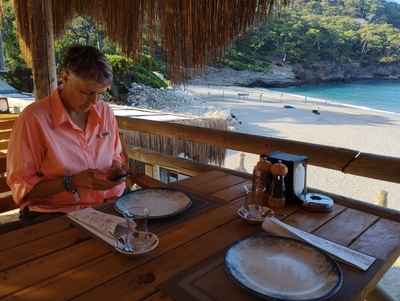
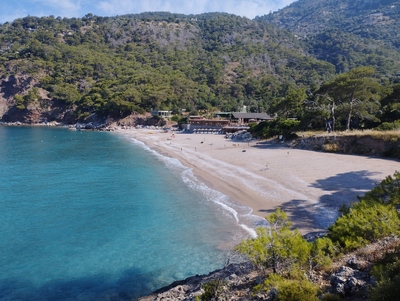
[Tuesday 13 June : Alinca] The TrailSmart app told us that the walk from Kabak Beach to Alinca was only six kilometres, but it was straight up with gradients of over 20% most of the way. So we knew we were in for a tough day, and it was. At least it was in shade most of the time, because without the trees keeping the sun off us I don't think we'd have made it. It was very hot, the incline was brutal and the path was stony and tough on the feet. Including a small detour to a delightful little waterfall, we walked for seven kilometres but that took six hours! This unnamed waterfall about a third of the way to Alinca provided a perfect break from the rigours of trekking. Water trickled down some mossy, fern-covered rocks into a small pool that was crystal clear. We waded into the pool and briefly plunged into the icy water. But aside from the steep gradients and killer heat, the scenery was beautiful and at every water stop we were rewarded with views that millionaires would die for.
A lunch stop on a level section of the path gave rise to a new game for our amusement: an olive pit spitting contest. We'd each eat an olive then spit the pip as far as we could. I'm afraid I have to say that Karen was awful at this rather unladylike activity - her pips never went more than about a metre or two. I, however, managed to seed several new olive trees on the slope below the path.
Hours and hours later we stumbled into the tiny village of Alinca, wrecked beyond belief. First we had tea (Turkish style) at a roadside stall operated by a wizened old woman who could speak no English, then we moved into an overpriced room at Bayram's Place. The guest house had been built in such a way that it had jaw-dropping views of the Mediterranean Sea far below ... until two hideous multi-storey mansions were built right in front of it. So the only view we had from our room was of a wrought iron fence, a blank white wall and a ghastly scar in the landscape where construction vehicles had driven with loads of bricks and building materials. The owners of Bayram's Place must have been livid. At least the swines didn't put windows in the wall.
[Wednesday 14 June : Patara] The tough walk from Kabak Beach up to Alinca was a turning point. We were no longer young and we finally had to admit that the Lycian Way was too much for us. We had intended to walk as far as Kaş but now we scrapped that plan; apart from anything else, at the speed we were going we simply would not make it in the time we had available. And we still wanted to see Cappadocia and Istanbul. So we engaged the young manager of Bayram's Place to drive us to the nearest bus stop (in the dusty village of Esen) in order to catch a dolmus down to Patara. Patara was the village at the eastern end of Patara Beach, a fabled stretch of sand 18 kilometres long that is often rated as one of the finest beaches in the Mediterranean.
Of course, these spur-of-the-moment plans seldom work out perfectly. Dolmuses from Esen only go as far as the town of Kilik; in fact, they don't even go into Kilik - we had to walk 500 metres to the bus station from where we were dropped on the edge of town (the driver had told us it was a 100 metre walk, but by now we were so well-attuned to Turkish distances that it didn't surprize us at all that it was considerably further). However, this interruption of our journey turned out well - on the way into Kilik we spotted a sign pointing up to the Xanthos Ruins. We'd read about this ancient Greek/Lycian settlement and decided to visit it. We trudged up a steep hill, paid 50 Lira each and wandered around amongst stone buildings dating back 2400 years or more (the Lycians pre-dated the Romans). No real attempt has been made to restore anything, so many of the monuments weren't much more than piles of stones. But the amphitheatre was still largely intact, as was the stadium used for ancient Greek athletic events.
Back down at the bus station we found a dolmus going to Patara. It drove a slow route out of Kilik, showing us that the town was way bigger than we'd originally thought. At a turnoff stating "Patara 3 km" the bus pulled over and the driver shouted back at us "Patara Beach!" We hopped out, bewildered. No beach was in sight and the sign above our heads said Patara was three kilometres away.
Then a guy came walking over and pointed to another dolmus parked nearby. "Patara," he said. It looked like our dolmus was heading somewhere else and Patara-bound passengers had to transfer to another bus for the side journey. But we'd paid for tickets all the way to Patara already, so this second dolmus had to be free. We hauled our luggage into the dolmus and sat waiting. "Two minutes," said the guy. "Another dolmus come." Less than a minute later a dolmus pulled up from the opposite direction and a swarm of people got out. They all crammed into our bus until there were no more seats available. Some had luggage, some didn't. All were foreign.
The guy got into the driver's seat and we pulled away. He drove fast and within minutes were we passing through a town clinging onto a steep slope. This had to be Patara Village. It was attractive and obviously tourist-oriented; we saw loads of hotels and restaurants. At least we wouldn't have trouble finding somewhere to stay. The bus stopped in what looked like the middle of town and several passengers got out. These seemed to be the ones with luggage. Karen and I looked at each other. "Should we get out?" she asked.
It was a tough call. But we wanted to get to Patara Beach, not the village. "No, let's stay on," I said.
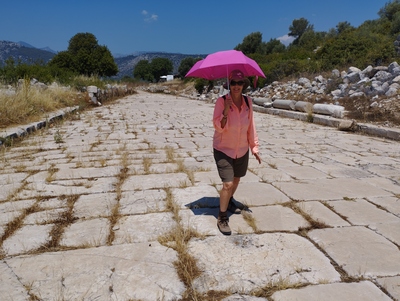
A kilometre or so further we arrived at a toll gate. At least that's what I thought it was until a woman hopped on from an office next to the road and scanned the passengers on board. She was wearing a uniform that looked remarkably like that of an SA Parks Board ranger. She spoke to the people ahead of us and I heard numbers like "Six hundred Lira" and Four hundred Lira." They reached for their wallets. We were sitting right at the back and her eyes roved over us. "Are you two together? Two hundred Lira each. Four hundred Lira total."
Finally it dawned on me. The Patara beach area was a protected conservation zone and it cost 200 Lira to enter. That was why the passengers with luggage had climbed off the bus - they were going to check into hotels in Patara Village. The ones without luggage were going to the beach for the day. "We better get off," I said. "We have to find a hotel before we cough up four hundred Lira to go to the beach. We can come back when we've dumped our luggage."
We exited the bus, past the woman waiting expectantly for us to pay up. She looked suspiciously at me as I tried to explain that we would find a hotel in the village then come back on foot. "You must still pay," she said. "No difference if you come in by bus or walk in. It is two hundred Lira per person." We'd realized that but it was pointless trying to explain further. We simply got off and headed back towards town. It was a little irritating that we had to walk back almost a kilometre on a road that we'd just driven on a bus, but that's the price you pay for not researching what you're going to do before you do it ...
Back in Patara Village we went into the first hotel we came to. Pansiyon Letoon's rooms were cheap, dim and dismal, as was the owner. Thuthaliya Hotel was only marginally better. Golden Pansiyon was an overpriced ripoff. But the fourth place, St Nicholas Pansiyon, was perfect. And it was cheaper than the previous two places! We moved into a fantastic room with a balcony overlooking the swimming pool, dumped our gear, changed and dived into the pool. The water was heavenly. Supper was cheese and mushroom pide (Turkish pizza) and elma çay (apple tea) at a local sidewalk joint down the street.
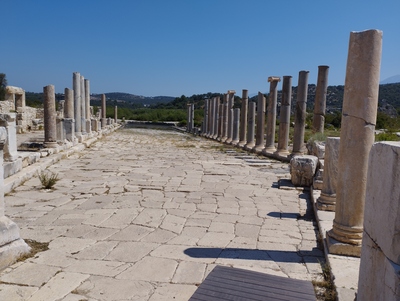
[Thursday 15 June : Patara] The famed Patara Beach was calling, so straight after breakfast we headed out. Although leaving the breakfast buffet at St Nicholas Pansiyon was difficult - they had an espresso machine! We hadn't had real coffee at a hotel in Türkiye since we'd been in Fethiye, 7 days before. It was only an automatic push-button machine, but still ... Karen had an espresso and I had three Americanos. Who knows, perhaps we won't see real coffee again for another week? The owner of the hotel was in attendance at breakfast and I had long chat with him. Turns out he wasn't Turkish but from the province of Transylvania in Romania (home of the Dracula legend), and he jokingly showed us two bite marks on his neck. He was a coffee afficionado himself, which was why there was an espresso machine at the hotel. He apologized for the fact that the coffee he was using wasn't Lavazza (the absolute best coffee on the planet). Lavazza or not, it was still excellent.
A few hundred metres down the road from Patara Village we arrived at the entrance gate where we'd hastily jumped off the bus the previous day. This time we paid the steep 200 Lira entry fee and walked through, looking over the surrounding fields for signs of the ancient Greek/Lycian city whose ruins pepper the hillside [Aside: The ruins of Patara are estimated to date back 2600 years]. The Triple Arched Gateway was right next to the road and magnificent, but more was to come. The Lycian League Assembly Building (a sort of parliament for the region) featured a remarkably well-preserved mini amphitheatre that was once used by politicians to discuss weighty matters, and right next to it a much bigger outdoor amphitheatre appeared still to be in use to this day. Around the lake we found the original lighthouse, an impressively tall structure that once indicated the shoreline of the Mediterranean Sea (which has receded dramatically in the last 3000 years); unfortunately it was being restored to its original glory so a huge crane, scaffolding and building materials rather spoiled the view.
We were stunned to see a serious infestation of Port Jackson trees on the path around the lake. "Port Jackson" is the colloquial South African name for the Acacia saligna tree, a tough and extremely fast-growing Australian plant that grows prolifically in any reasonably hot environment and in soils with low nutrient content. It was brought to South Africa in the 19th century and since then has spread dramatically, and in some areas of the Western Cape the tree is totally out of control. These trees swamp all indigenous vegetation and dry up watercourses through their voracious appetite for water. Port Jackson infestation has become a real problem in South Africa; teams of "hackers" work full time cutting them down and poisoning the stumps - it is almost impossible to kill a Port Jackson tree without taking it out roots and all. And the root is usually as deep as the tree is high, so once it is over a metre tall it is extremely difficult to pull out. Poison is then the only solution.
It appears as if Türkiye has the same problem as South Africa, and not only with Port Jacksons - we saw plenty of Eucalyptus (gum) trees as well. These are also invasive aliens from Australia, but at least they grow relatively slowly.
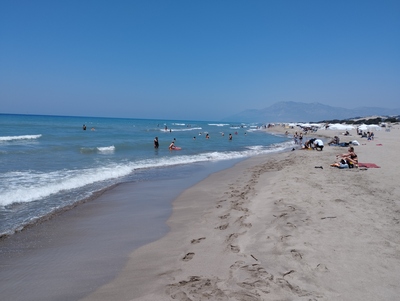
After seeing the ancient Greek lighthouse we were both ruined and ruined-out, in the first case by the heat and in the second by 2000-year-old relics. Next stop was the beach. And indeed it was beautiful, but the best part about it was that it was soft sand and not stones! I suppose, being from South Africa, we are spoilt for choice, because I've seen many beaches that are more beautiful than Patara Beach ... but this was Europe and Patara Beach was up there with the best of them.
It was so hot you could not walk on the sand without shoes. We dived into the sea (warm, as usual) and enjoyed a long slosh in the puny waves. Afterwards we could not take the relentless heat, so we retired to the rustic beach cafe and sat under the shade of palm fronds. It was amazing seeing hundreds of people out in the sun, without hats or shirts, being roasted to a deep pink and apparently enjoying it ... have they not heard of skin cancer? Some of the sun worshippers we saw had skins like dried out old leather.
Supper was simply outstanding. Köfte (meatballs) with potatoes, rice, stuffed green peppers, roasted aubergines, chick peas and mixed vegetables, all washed down with elma çay (apple tea), left us replete.
[Friday 16 June : Kaş] We were back on the road again today after a two-day break, this time to Kaş, a biggish town 40 kilometres further down the coast to the east. Kaş was where we had originally planned to end our Lycian Way trek, but now that we'd abandoned that madcap plan we were going to get there several days earlier. The bus stop was right next to the entrance to our hotel, so we hardly had far to walk. Unfortunately the scheduled departure time of 10:15 came and went with no sign of a bus. Three British tourists and two Turks were also waiting for the bus and looking at their watches as the minutes ticked by. We fell into conversation with the Brits (three middle-aged women). One of them had been married to a Turk and had lived in Türkiye for 18 years, so she could speak excellent Turkish. The other two followed her lead, but not in any sheep-like way; in fact, they were marvelously independent and a fine example of how people of any age and gender could travel the world without guides or package tours. They were staying in Patara and just going to Kaş for the day.
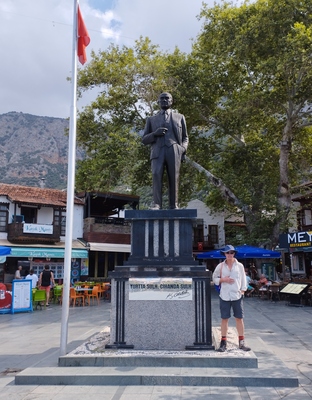
Eventually the bus arrived, half an hour late. This was unusual for Turkish public transport - our previous experience with Turkish buses and trams (no trains yet; there are no railway lines along the Mediterranean coast, mainly because of the mountainous terrain) was that they were generally punctual and efficient. Even one of the Turks waiting with us was rather mystified as to why the bus was so late. We hopped on and a few minutes later had to get off again at the same intersection where we'd changed buses two days before. It seems that Patara buses simply do a loop of about six kilometres, from the beach through town and to the intersection with the main east-west road, at which point they turn round and go back again.
The Kaş-bound bus was packed to the gunnels. People were standing down the aisle and hanging onto every available protrusion as the bus slowly ground its way up the steep and twisting road from Patara. Our speed slowed and the driver changed down to second gear as the gradient increased. Hairpin bend followed hairpin bend. I was sitting jammed against the window in front and could feel the engine labouring on the slope. "Change down to first gear," I mentally willed the driver. But he didn't and remained in second gear. We were near stalling speed when the driver finally changed down to the lowest gear, but he was too late. The moment his foot hit the clutch the bus came to a standstill. He tried to get the bus going again, revving the engine deeply, but the wheels simply spun on the road and we didn't move. The problem of an overloaded bus on a steep slope was compounded by the fact that it had been raining and the road surface was slippery. The driver tried again with the same result; the wheels spun, kicking up loose stones and gravel, but could not get traction. We were stuck.
The driver turned round and shouted something in Turkish, opening the door at the same time. I had no idea what he said but the meaning was clear - some people had to get off, otherwise the bus would not move. The passengers standing near me were mostly teenagers, and they looked at each other with shock and disbelief. Their reaction told me that this was a pretty unusual situation. There was lots of incredulous jabbering but nobody got off. Eventually an older man stepped out into the road. Several teenagers reluctantly followed suit. I would also have got off, but I was wedged into a corner and could not easily extricate myelf. The driver evidently thought that the load was now light enough, because he revved the engine again and very slowly released the clutch. Would the wheels bite? There was a moment of uncertainty, then I felt the bus inch forward. The speed picked up agonisingly slowly. This time the driver stayed in first gear and kept the bus moving steadily up the hill until we reached an area where the gradient levelled off. He stopped and opened the door again. A few minutes later the passengers that had stepped off climbed back on again, out of breath and talking and laughing amongst themselves. When everybody was on board the driver started up again. He didn't allow the revolutions to drop too low again and we made it to the summit of the road without the need for further intervention.
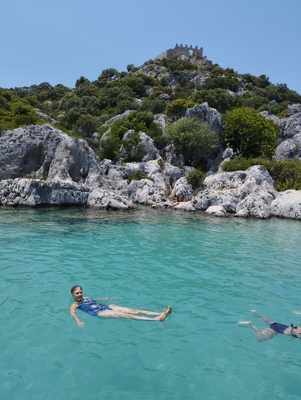
A quick detour into the tourist resort town of Kalkan was followed by descent to a road of breathtaking beauty. From Kalkan to Kaş the road hugs a cliff that plunges straight down into the sea. It was reminiscent of two iconic coastal drives in South Africa's Western Cape - Chapman's Peak Drive (between Hout Bay and Noordhoek) and Clarence Drive (between Gordon's Bay and Kleinmond). The views acrosss the Mediterranean were superb. At one point we passed an area where cars were parked all over the place, packed into a couple of small parking areas cheek-by-jowl and alongside the road in every available nook and cranny. Ooh's and aah's from the people in the bus who were on the sea side and looking down told me that we were passing Kaputaş Beach, a stunning but tiny beach gouged out of the sheer cliff. Unless you come by boat, the only way to reach this beach is to park on the road above and descend a long and precipitous stone staircase. Clearly many people thought the hard slog down and then back up again was worth it.
Kaş itself proved to be heavy with traffic and tourists. But the bus station was close to the harbour and town centre, so it was a simple matter to walk a couple of blocks to an area where there were reputed to be a lot of hotels and pansiyons. In fact, there were so many of them that we hardly saw anything else. A small side street revealed rows of pansiyons, packed close together and all advertising "vacant room." Hotel Puya had a room for that night but not the next; Pansiyon Pinar's rooms were cramped and the bathroom had that most irritating of features - a "wet room" with the shower above the toilet. But our luck was in at Meltem Pansiyon - the friendly manager there showed us a spacious room that had been recently renovated. Its bathroom featured a separate shower and there was a sunny balcony overooking a courtyard shaded by a mini-forest of lemon trees. And it was only 800 Lira per night, including breakfast! We were sold and checked in for the next three nights.
[Saturday 17 June : Kaş] Finally a relaxing day ... we had no activity planned, no place we had to get to, no bus to catch, no steep mountain to climb. We wandered around Kaş, enjoying the festive weekend atmosphere and getting mildly lost in the old town. The old town wasn't a labyrinth of cobbled lanes and medieval stone houses as is the case in many European cities, but rather an area that has become something of a tourist trap. The streets were indeed narrow and winding, many (but not all) of them pedestrianised, but the buildings weren't particularly old. Cafes, restaurants, bars, coffee shops, smart hotels, shops selling crafts or tourist trinkets, and agencies flogging boat trips abounded. The warren of lanes was spotlessly clean and very attractive, and on those few roads where cars were allowed people drove slowly and gave way to pedestrians.
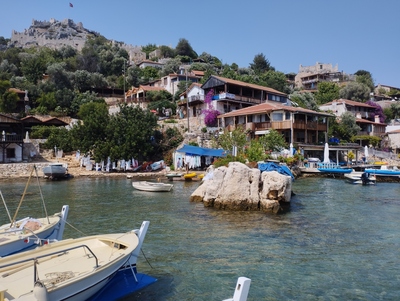
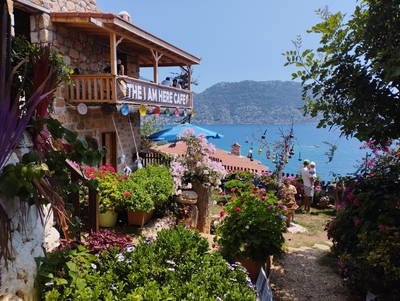
Every enterprise had a tout stationed outside trying to entice the strolling tourists into their establishment. "Merhaba! You want breakfast? Coffee?" or "Kekova Island boat trip?" or "You want to see menu?" was the chorus of plaintive calls as we walked along. In truth, these touts weren't hard-sell or unpleasant and always smiled in return when we replied with "Hayir, teşekkür." We enjoyed some ridiculously expensive but excellent coffee at a place called Biiisstt (yes, that is exactly how its name was spelt), looking out over the calm waters of the Mediterranean.
The attitude to coffee in Türkiye is a little different from what I expected. Turkish Coffee (where the grounds are boiled on a stove to produce a very thick, strong mixture) is not drunk much at all. People seem to have one cup of Turkish Coffee in the morning (if at all), and thereafter they drink black tea, copious quantities of it. Espresso-based coffee is rare and only available in tourist areas - we did not see it at all in the rural villages on the Lycian Way. And when you do find espresso-based coffee it is expensive. You can get instant coffee everywhere though; it is usually labelled "Nescafe" on menus because that it is the dominant brand in Türkiye. Milk is also unusual. Turks drink their coffee and tea black, so if you want milk you have to make a point of asking for it. Turkish Coffee has a very distinctive spicy taste, cardamom perhaps, and I didn't enjoy it much. But Karen developed a liking for it and often had it at breakfast.
[Sunday 18 June : Kaş] We wanted to go to Kekova Island, but getting there independently was going to take a lot of effort and time. So we shelved the idea of staying on the island and signed up for a day trip instead. At 9 am we were waiting at Gümüs Travel's office, together with a Russian couple and a young child clinging to her father's hand for dear life. At 9:30 a small bus arrived, already full of tourists that had been collected from other hotels in and around Kaş. The driver sped off on the main road towards Antalya then hurtled down a steep side road at breakneck speed. We hung on as the bus bumped and swayed round tight corners, overtaking cars and scaring motorcyclists. Finally the gradient eased off as we approached the small town Üçagiz (or Kaleüçagiz). Our Formula 1-wannabee driver was forced to employ what was (for him) a seldom-used technique - braking.
At Üçagiz harbour we trooped onto a wooden boat. It was much bigger than I thought it would be and had an upper deck that was partly shaded and a lower deck that was much cooler. Many more passengers boarded while we sat waiting. All of them were Turks - they'd obviously come to Üçagiz in their own cars rather than via the boat company's bus. Eventually, after a great deal of fannying about, the boat eased away from the dock. It was only 10:30 am, but the sun was already scorching hot as we chugged out into the Mediterranean Sea.
For the rest of the day we motored around a bewildering number of small islands and sheltered coves, stopping to swim four times (we just dived off the boat into crystal clear, warm water) and going past the ancient sunken city of Simena near Kekova Island. This Lycian city, now under twenty metres of water, was submerged when a series of earthquakes in the second century BC opened a channel into the sea and the Mediterranean poured into what was previously a fertile valley. Unfortunately the sunken city was rather underwhelming when you looked down on it from above the water - despite the clear water all we could make out were the shadows of buildings and columns. Far more intersting was the stop at the charming cliffside village of Kaleköy. This tiny settlement hugs the steep slopes of a hill that plunges directly into the sea, and consists of a few pansiyons on the water's edge, a small harbour and a stiff climb up to some Lycian ruins that were built high enough to be out of reach of the floodwaters. The village has no road access - you can only get there by boat or on foot via a rocky scramble from Kaş. The views across the Mediterranean from Kaleköy were those that millionaires dream about (and pay fortunes to get, provided they can reach them in their Porsche or helicopter).
It was a long day, but a relaxing one; we didn't even panic as the deranged maniac at the wheel of our bus burnt up the rubber on the way back to Kaş.
[Monday 19 June : Antalya] The first part of our trip was over. We had to return to Antalya to collect the luggage we'd left there before we embarked on our doomed (or mad, depending on your point of view) endeavour to walk the Lycian Way. A bus to Antalya was just about to leave as we walked into Kaş bus station, so we hopped on and enjoyed a scenic three hour drive along Türkiye's Turqoise Coast. Brief stops in Demre and Finike punctuated the journey. From Finike onwards the road hugged the coast, with every sharp curve revealing another little beach between two rocky headlands. The views were stupendous. By 1 pm we were trudging back down the familiar underpass from Antalya's bus station to catch the tram into the city centre. We even recalled how to get to Hotel Twenty from the Ismetpasa tram stop!
[Tuesday 20 June : Pamukkale] We were back on the road again today, this time to Pamukkale. This entailed a three hour bus ride to the thriving city of Denizli, followed by a dolmus for the short hop to Pamukkale town. Getting the dolmus was easy - Denizli's modern bus station has long-distance buses on the top level and local commuter buses at the bottom level, all neatly numbered and labelled. But then it became tricky, partly through our own fault. We thought dolmuses to Pamukkale terminated in town, but it turns out they merely stop there before continuing on to the even smaller towns of Develi and Karahayit. So we weren't quite sure where to get off as the bus wound its way through Pamukkale. "Better to wait until the end," I said to Karen. She nodded. It didn't help that only a couple of other passengers got off in what we later discovered was the centre of Pamukkale. The rest stayed on board, so we did as well.
Next moment we were out of town and hammering up a steep road round the mountainside. We realized that we'd erred and should have got off, but now it was too late - there were no bus stops, it was blazing hot and it was kilometres back to Pamukkale. All we could do was stay on board and hope the bus turned round and went back again. None of the passengers could understand English and just stared at us blankly when we asked "Pamukkale?" One older guy wearing a hi-viz vest smiled and waved his arm to indicate that we should sit down. Did he understand? Did that mean the bus would go back? Unfortunately it was a firm "no" on both counts - the hi-viz vest guy got off in the village of Develi, after which the bus headed further away from Pamukkale.
By now the driver was getting irritated with us. We screeched to a halt in the middle of the road just as I noticed a bus coming the other way towards us. The other bus stopped a little way further on. Our driver beckoned to us, jumped out and took our bags out of the hold. "Pamukkale," he said brusquely, pointing at the other bus. We grabbed our stuff, ran across to the other bus and jumped on board. The two drivers had a brief conversation, then both buses roared off in their respective directions. We'd tried to pay the original driver but he just waved us away.
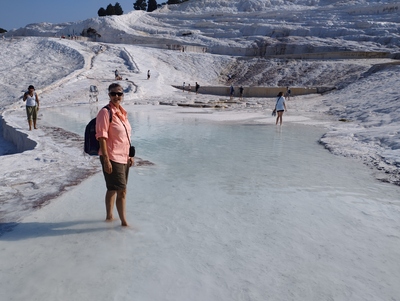
Our new transportation retraced our route from earlier and a few minutes later we found ourselves back in the centre of Pamukkale. This time we managed to engage our brains sufficiently to get off. The fare was a paltry 14 Lira each, from which I surmised that we'd only paid for the trip from Denizli, not for the extra driving around that we'd done. We realized, not for the first time, that most Turks are decent and scrupulously honest.
The first hotel we went into in Pamukkale was so bad we didn't even look at a room. The place looked like a derelict tip. We left with the manager's plaintive calls of "I give you cheap room" ringing in our ears. Further up the road the Mustafa Hotel was considerably nicer. It was even listed in our Lonely Planet travel guide! We took a corner room for two nights and revelled in loads of space after the cramped confines of Hotel Twenty in Antalya.
[Wednesday 21 June : Pamukkale] The sun was already hot at 9 am when we started walking up the hill to the famous calcite travertines of Pamukkale. We had to take our shoes off just after going through the entrance gate (where we paid a steep 400 Lira each to get in) and slowly made our way barefoot up the gleaming white slope. The water running over the white rocks made the slope look dangerously slippery, but it wasn't - the bottom of each stepped pool was soft calcite and the path along the sides was smooth but strangely tactile to the touch. The water was cold, which was odd; it originates from a thermal hot spring so I expected it to be hot, or at least warm. Perhaps the water loses temperature during the course of running down the mountainside.
At the top of the hill we found an obscenely overpriced tourist trap of a restaurant (90 Lira, or 75 SA Rands, for coffee) and a swimming pool fed by water from the hot spring. Of course, going into the pool wasn't included in our ticket but was 130 Lira extra. And the water was so hot the people in the pool were just sitting in it and barely moving, while the brutal heat and sun of midday assaulted them from above. The shade of the open-air cafetaria was infinitely preferable.
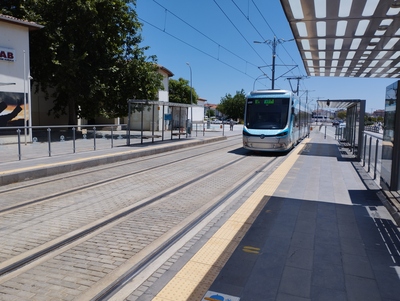
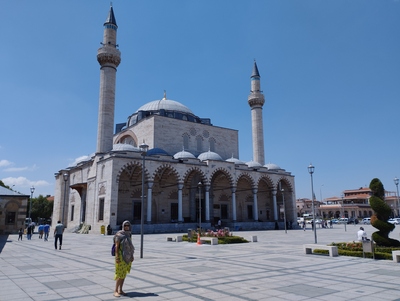
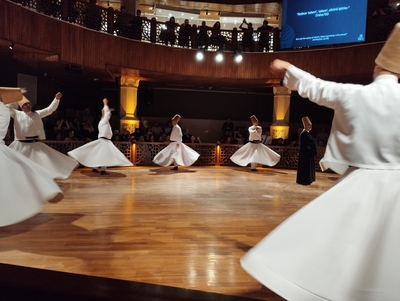
Higher up still are the ruins of the ancient city of Hierapolis. Originally Lycian, then Greek, then Roman, the remains of this once-thriving spa settlement (back then people enjoyed hot pools just as much as we do today) are spread over a wide area. It was energy-sapping walking amongst the ruins in the heat, but the climb to the top of the Roman amphitheatre was worth it. The remarkably good condition of this huge theatre is due to the generosity of an Italian consortium that funded its restoration in 1957. Less lucky was the church commemorating the martyrdom of the apostle St Philip - it stands silent and ruined, the roof gone and the thick stone walls scattered around. All that remains are the arches that once existed in each of the eight sides of the church. It is a sombre place, built in the 6th century AD on the exact spot where St Philip was killed by an angry mob.
The walk back down to town in the bright sun of midday was murder on the eyes. The dazzling reflections from all sides on the white travertines made me feel dizzy, and I sought refuge under the one and only tree on the entire slope. Karen simply lay on her back in the water, fully clothed, grinning with delight.
[Thursday 22 June : Konya] Getting to Konya from Pamukkale was a fifteen hour ordeal, induced by the unexpected onset of the Turkish school holidays. We had tried to buy bus tickets from Denizli to Pamukkale the day before, only to be told by two different agents that every bus by every company for the entire day was full. The only availability was on one that left at 10 in the evening and arrived in Konya at the delightful hour of 4 am. We debated what to do, and in the end decided to get to Denizli as early as possible and hope for a cancellation (Pamukkale to Denizli was easy - commuter-style dolmuses plied this route every twenty minutes all day long. The Denizli-Konya leg was the problem).
At 7 am we were standing in Pamukkale's main road, waiting for a dolmus. The next one was at quarter past, and by 7:40 am were in Denizli bus station, going from one bus company ticket counter to the next, asking about buses to Konya. The answer was the same - all full. A helpful guy suggested that we take a bus to Afyonkarahisar first, because there were lots of tickets available on that route and there were frequent buses to Konya from Afyon. He was adamant that we would easily get seats on a bus from Afyon [Aside: Afyonkarahisar, usually abbreviated to Afyon, is a city approximately halfway between Denizli and Konya, but to the north].
What choice did we have? If we stayed in Denizli we might not get on a bus at all and have to spend the night there, losing out on our pre-booked hotel in Konya. And apparently buses the next day were just as full. At least going to Afyon would get us closer to Konya, and it was a plan that sounded like it would work. We duly bought tickets on the 9 am bus, arrived in Afyon just after midday and sprinted for the ticket counters. Bad news again, but this time there was a ray of hope - one company had a few seats left on a bus to Konya at 4:30 pm, scheduled to arrive just after 7:30 pm. That meant a wait of over four hours, but the ticket seller (who spoke remarkably good English) assured us that if there were any cancellations on an earlier bus he would change our tickets for us. "No extra charge," he said. "Just make sure I can find you." So we stationed ourselves at a table at a defunct cafe in the concourse within sight of the ticket office.
And there we waited, and waited, and waited ... Several times our friendly ticket-seller walked past and shrugged his shoulders at us. Clearly there were no cancellations. Every time a bus to Konya departed we made sure we were ready to run if called, but nothing happened. At 4:15 pm we loaded up our gear and wandered out to the boarding platform. No bus. Again we waited, and waited, and waited ... Several times we asked different people, and on each occasion we were told to wait. The bus was late. It would be there in ten minutes. And so on. The ten minute delay turned into a minute short of an hour; we finally departed at 5:29 pm, 59 minutes late. That meant arrival in Konya at 8:30 pm. Or perhaps even later. And, having learnt our lesson, we knew that when we got to Konya we had to buy our tickets from there to Cappadocia immediately, lest we run into the same problem again in three days' time. Konya's bus station was also a long way from the city centre, so we would have to negotiate the tram from the station into town then find our hotel in the dark. It was going to be a long day.
And a long day it was ... The bus arrived in Konya at 8:35 pm, and straight after disembarking we started the whole rigmarole of buying tickets to Göreme in Cappadocia. Company after company told us their buses were full. Eventually, the sixth or seventh ticket office we tried had seats on a bus going to Nevşehir at 11 am in three days time. The time was right and Nevşehir was a reasonable alternative to Göreme - it was only 12 kilometres away and apparently there were frequent local buses between the two.
That done, we dragged our weary legs down the walkway to the tram stop. By now it was after 9 pm and dark. A tram was just arriving as we got to the station, and despite frantic fumbling with my credit card I could not swipe it over the automated turnstile quick enough. We stared in dismay as the tram moved off, leaving us standing on the platform. I groaned. More waiting. And it was already late. Fifteen minutes later we stepped onto the next tram. It was remarkably similar to the ones we'd seen in Antalya - silent, clean and modern.
Trams on the line from the bus station went into Konya's city centre, looped round a park then returned back the way they'd come, so we made sure we got off at the Alaedin stop on the far side of the loop. From there we could change to another line and ride a short distance to a tram stop nearer the hotel we'd booked, but at that time of night (9:45 pm) we might wait another ten or twenty minutes. It was easier just to walk. The distance was only about a kilometre and the night air was balmy. We arrived at Sufi Homes Hotel on the dot of 10 pm, 15 hours after we'd left Pamukkale. For the first time on this trip I began to question whether, at our age, we were still up to this type of seat-of-your-pants travelling ... we were mentally drained and physically exhausted. At least the hotel had 24-hour reception, so we didn't have to bang on doors or phone an after-hours number to get in.
[Friday 23 June : Konya] Konya is the city where the Whirling Dervishes originated. The Order of the Whirling Dervishes (or the Mevlevi Order), famous for the Sufi dance known as the Sema, was founded in the 13th century in memory of a revered Sufi mystic named Jalal al-Din Muhammad Rumi. Rumi, nicknamed Mevlana, died in 1273 and was buried in Konya. The Mevlana Museum in the centre of Konya documents the life of Rumi and the history of the Whirling Dervishes.
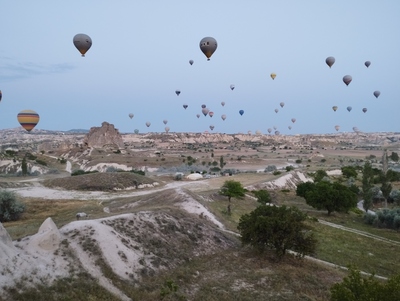
The Dervishes are devout Muslim monks who spend their lives studying Islam and learning the Dervish traditions. Their repetitive dancing is seen as a form of meditative contemplation. They conduct Sema ceremonies several times a week, and we were lucky enough to discover that there was a free ceremony open to the public every Friday evening. We booked tickets for that night then explored the Mevlana Museum. We also discovered the bazaar district of Konya, a rabbit warren of narrow streets where anything and everything was for sale. It was very clear that Konya was not a tourist town - during our wanderings we did not see any other Westerners and none of the locals we tried to talk to could speak a word of English. Luckily we knew a smattering of Turkish, enough to buy a kebab or a bag of cherries.
The Whirling Dervish ceremony that night was fascinating. It was a deeply religious display of the Muslim faith, with a big screen on the wall explaining in both Turkish and English the meaning of each ritual. Thirteen dervishes participated, one of whom was a very old senior cleric who did not whirl but recited incantations. Another was a sort of monitor who walked among the dervishes, possibly checking that their movements were correct. The remaining eleven wore white tunics and trousers, and a flouncy sort of skirt that spun outwards as they whirled. They were mostly young men in their 20's and 30's but one of them was only a teenager and a couple were somewhat older. During the ceremony the dervishes whirled on four occasions, each time for about five minutes. They never showed the slightest sign of losing their balance, nor did they seem to tire. It was a truly extraordinary experience.
[Saturday 24 June : Konya] We had originally thought the public Whirling Dervish ceremony would be on Saturday, but we'd managed to attend one on Friday so we had nothing planned for today. We strolled around Konya, drank some dismal coffee at a place near the Selimiye Mosque and ate a fantastic meal of tavuk şiş (chicken kebab) at a crowded local eatery in the bazaar district. We sat surrounded by Turks eating and drinking tea (there's no alcohol in Konya), and were served delicious crusty bread, egg salad, a spicy sauce and chicken so tender and flavourful that it was a taste sensation.

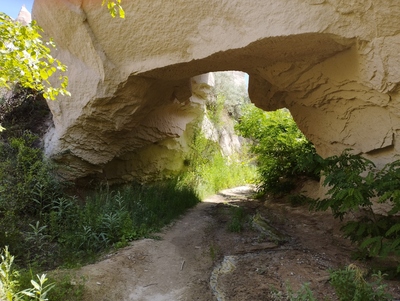
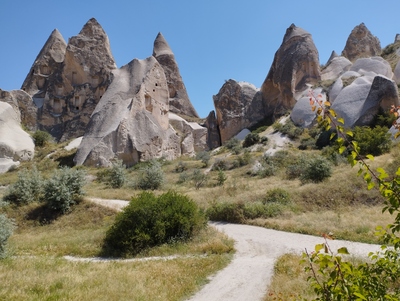
While we were eating I spotted three Westerners (two men and a woman) approach the entrance to the lane in which we were sitting. They were obviously not local by their mannerisms and the fact that they were all wearing shorts; Turks in Konya simply did not wear shorts, ever. The hesitated, looked around, and must then have noticed us because they walked down the lane and straight to our table. "How's the food here?" asked one of the men in English. His accent was unusual and I couldn't quite place it. He definitely wasn't a native English speaker, and nor was he German, French or Italian. Dutch or Belgian perhaps?
"Fantastic," I replied. "We ate here last night and it was so good that we came back again today."
The chap turned to his two companions and said "Hulle se die kos is goed hier. Sal ons ook hier eet?" I stared, gobsmacked. He'd spoken Afrikaans! They were also South African! What were the chances of that?
"Ja, dit is baie goed. Jy sal nie teleurgesteld wees." I replied in kind, and it was comical seeing the looks of astonishment on their faces. Turns out they were also from Cape Town, and were on a golfing tour of Turkey in a rental car, going from golf course to golf course. They'd played on a number courses around Antalya, in the exact area where we'd been for the first two weeks of our trip. They did indeed eat dinner at the same restaurant, and when we left they were tucking into huge plates of lamb and chicken. They obviously didn't know that Konya was Türkiye's most devoutly religious city; we overheard them asking for beer, but the closest they got to that forbidden poison was Coca Cola. I'm guessing the local food they ate that night made a welcome change from the bland fare they'd been served at the plush golf resorts they were staying in.
[Sunday 25 June : Göreme (Cappadocia)] Another frustratingly hard travel day, again a result of the Turkish holidays causing congested mayhem on bus services. Our bus from Konya was comfortable, with tea, coffee and snacks served on board, but it deposited us in Nevşehir's inconveniently-located bus station at 2 pm, about 5 kilometres from the centre of town. We didn't even want to be in Nevşehir; however, we had been unable to get seats on a bus to Göreme in Cappadocia, and Nevşehir was the best we could do. Nevşehir was a mid-sized city 12 kilometres from Göreme.
Nevşehir's bus station was windswept, hot and deserted. Nobody could even tell us how to get into the centre of the city, never mind get from there to Göreme. A guy in a bus company sales office looked up from cleaning his nails long enough to point to the door then to the right. We went outside and looked around, but no buses, or even taxis, were in sight. A few people were waiting at a faded sign to the left. We asked them and a girl who could speak passable English seemed to think that this was the right spot to wait for a bus into town. I wasn't sure at all - we had gone in the opposite direction to that which the guy in the bus station had said. We decided to walk right round the parking lot to the right but no miraculous revelation was apparent. However, we did encounter two elderly Turkish people dragging wheelie suitcases round in a "Where the hell am I?" sort of fashion, and when I queried "Nevşehir?" they nodded and pointed vaguely in two different directions. One of the Turks went over to a derelict building which I assumed was abandoned but which turned out to be the security office, and came out a minute later. "Nevşehir," he said, and headed down a grass embankment with his suitcase bumping along behind him. We followed and emerged onto the access road into the bus station. A minute later a bus came along. The driver nodded when I asked "Nevşehir?" All four of us (the two Turks and us) piled on board. The bus made a u-turn then proceeded towards the city centre.
The next problem was how to find a bus to Göreme. It would be incredibly stupid to repeat the mistake we'd made in Pamukkale, when we stayed on a local bus on the assumption (proved false) that it would terminate at some central station. So as soon as we neared the built-up area I went to the front of the bus and asked the driver "Otobüs Göreme?" He nodded and waved his arm ahead. At least he now knew where we wanted to get off.
The bus drove for miles through town, until finally the driver slowed and hollered "Göreme!" We grabbed our gear and hustled to the front. But the bus didn't stop - instead the driver pointed out of the window at two bus shelters we were passing. "Göreme otobüs. There! You understand?" I nodded dumbly as we sailed past. Why didn't he stop? But even Turkish buses have to stick to a pre-programmed schedule; a hundred metres further the driver pulled over at a different bus stop, one that was obviously on his route. We climbed out and he pointed back again. We humped our stuff back to the bus stop he'd indicated and waited. Several buses passed but not for Göreme. Finally one arrived and a few minutes later we were descending into the Cappadocia Valley, quite possibly Türkiye's most famous attraction.
Even from the bus the views were staggering. There were pale sandstone rock formations everywhere, overlapping and jumbled, but mostly jutting up in the distinctive cone shape I'd seen in countless photographs. It was a fantastic, other-worldly scene, so utterly different from the flat plains we'd driven through from Konya that I stared in amazement. Suddenly I realized what all the fuss was about, and why everybody said "You must go to Cappadocia."
But reality intruded quite quickly. We stepped out of the bus at Göreme's bus station and trudged off in search of a hotel. We'd tried to book one, but our plans were foiled by the fact that Booking.com had blocked all hotel reservations in Türkiye and several attempts to book a room via Hotels.com using different credit cards resulted in a "connection error" each time. So we had no booking, and we quickly discovered what that meant in Göreme during the Turkish holidays - hotels were full, or the prices were steep. A place that had been 1100 Lira a night three days before was now over 2500 Lira a night! Luckily every street in Göreme is lined with hotels, so we just went from one to the next. It was bad news each time. Finally we arrived at the Kismet Cave Hotel, a place that one of Karen's friends had stayed in a few years before and raved about. The owner was pleasant, he had a vacancy and negotiated a price that wasn't daylight robbery. We dumped our gear in the room and immediately had a cold shower each - the Cappadocia Valley is searingly hot in summer and we were both drenched with perspiration.
[Monday 26 June : Göreme (Cappadocia)] A hot day spent exploring Göreme's open-air museum, an area about a kilometre out of town that contains a number of ancient cave-cut Christian churches. These churches were hollowed out of the soft rock walls of the Cappadocia Valley during the Byzantine period of Turkish history (between the 4th and 10th centuries AD), long before Türkiye became a predominantly Muslim country. Many of the churches have intricate and beautifully-painted frescoes on the walls and ceilings. Because they were in man-made caves and thus quite dark, the frescoes have survived the centuries very well (sunlight is the enemy of paint). All the churches have long since been abandoned.
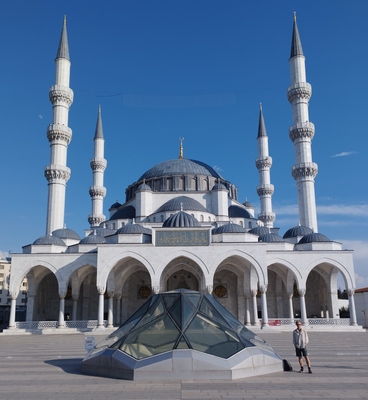
The churches (and simple dwellings) in the museum area are but a small sample of those in the Cappadocia Valley - there are many more outside the museum area that are freely accessible. But finding them takes a lot of walking in the hot sun, so the crafty buggers in Türkiye's Ministry of Culture and Tourism have fenced off those nearest to Göreme and now charge the outrageous fee of 400 Lira to see them. I say "outrageous" because it seems like very little of the tens of thousands of Lira they earn each day goes into maintaining the museum - the signage is terrible, there are no benches to sit on and the access road to the museum is a disgrace. But that's how it is in the 21st century when it comes to overwhelmingly popular tourist attractions - fleece the visitors for all they're worth and use the cash elsewhere.
[Tuesday 27 June : Göreme (Cappadocia)] An early (very, very early - we got up at 3:30 am) morning saw us standing in an open field in the pre-dawn darkness watching and listening to a great many hot air balloons inflate. Twenty tourists and two crew members climbed into the basket of our balloon and we lifted off. For the next hour, as the sun rose, we sailed serenely over the Cappadocia Valley, with balloons visible in every direction, above us, below us and all around us. It was pleasant and quite fun, but rather underwhelming and certainly not worth the amount we paid for the ride. At least we were dropped back at our hotel well before breakfast so we didn't miss out on that.
Karen wasn't feeling too well, so after breakfast I headed out on my own to explore the Cappadocia Valley on foot. I had a fairly rough map, a compass and Google Maps, but the latter proved useless once I'd veered off a side road just north of Göreme - the big G showed no paths, no tracks, no roads, just a big blank space. Ok, old school then. There were paths and dust roads everywhere, including several used by the legion of quad bike and 4x4 travel operators in Göreme who charge idiot tourists a fortune so that they can rip up the environment and create dust, noise and mayhem. One such lot came roaring up at high speed on the track I was walking on, and were forced to slow down and swerve because I refused to step aside and let them pass. I was walking along a backwoods dirt track, minding my own business and enjoying the peaceful surroundings; why should I give way to them? I suspect there was much swearing and cursing as they bumped past me.
I walked past some spectacular rock formations, over a range of hills and down the other side. I was looking for the fabled Red and Rose Valleys, and eventually I found a hiking signpost to Rose Valley near a defunct orange juice stand. I followed the path, upwards for a few kilometres, and then saw a very steep descent twisting off to the right. Down I went until I found myself in a verdant and green oasis. I'd found Rose Valley. It was strikingly beautiful, in complete contrast to the desert-like landscape of most of the valley; there were trees and bushes in abundance, crowding the path and providing shade. But how did this valley stay so lush in the brutal heat of Cappadocia? There had to be a natural watercourse somewhere. And there was - I exited Rose Valley not far from where I'd turned in (confirmation that I'd been walking on the loop marked on my map) and a short while later entered Red Valley. The path became muddy and at times water was flowing along it. This had to be the watercourse that was keeping Rose Valley so lush and green.
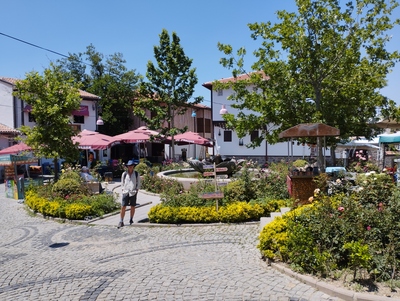
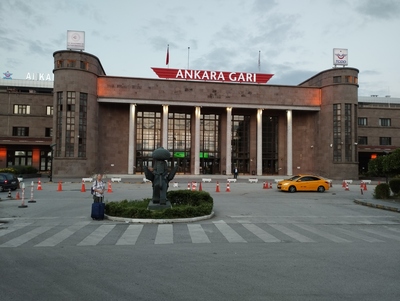
The path went through many tunnels in the rock. All of these appeared to be natural, gouged out by the flowing water under my feet. I wondered what the path would be like in the rainy season; a raging torrent probably. The path went on and on, and I kept eyeing my compass to make sure that I was at least heading in the right direction. By now I was getting tired, and it was with relief that I finally emerged onto the road that goes past the open-air museum. Unfortunately I was about a kilometre beyond the museum, so I had to walk a further two kilometres before I arrived back in Göreme. I'd walked for just over four hours and covered about 15 kilometres, but it was incredibly rewarding. The Rose and Red Valleys were definitely worth the effort and far more enjoyable than either the open-air museum or the vastly overrated balloon ride.
[Wednesday 28 June : Ankara] Another day, another bus, this time to Ankara, capital city of Türkiye. Ankara is one of the least-visited places in the whole of Türkiye, and everybody I'd spoken to had said "Don't bother going to Ankara; there's nothing to see there." That was enough for me to want to see it, because I'd heard the same negative mantra about other places that had proved to be extremely interesting (Canberra in Australia, for instance). Besides, Ankara was a convenient stopover on the way to Istanbul and allowed us to break up what would otherwise have been a very long journey from Göreme.It was Eid al-Adha today (the Feast of Sacrifice), a major holiday on the Islamic calendar and the bus was three-quarters empty, a welcome change from the overcrowding we'd become used to. The road into the national capital of Türkiye was a beautiful 6-lane freeway, and as we approached the city centre we saw extensive efforts being made to green the landscape. Ankara looked like a pleasant, orderly city. The bus station was immense, more like an airport than a bus terminues, and built over four levels. Our bus pulled into bay number 129! And that was by no means the last bay, so who knows how many busses the station can accommodate?
The bus station may have been big, but it was not at all user-friendly. There were no signs at all, and finding the Metro station turned out to be quite a baffling exercise. Buying a ticket was even more confusing, because the ticket counters were all closed and the automated turnstiles didn't seem to be working. A young lass saw our bewilderment and explained that all public transport in Ankara was free today because of the Muslim holiday. So we simply walked through the turnstiles and onto the platform. After that it was easy. A change of train at Kizilay, followed by exit onto the street at Ulus and a short walk saw us checking into the Rest Hotel at 3 pm. It was a standard business travellers' hotel, eerily empty on this non-working day in a city that is geared towards commerce and international diplomacy rather than tourism.
[Thursday 29 June : Ankara] Ankara has three major sights worth visiting, and today we went to two of them - the Museum of Anatolian Civilizations and the Citadel (Ankara's old town and partially-ruined city walls). We didn't have the energy to visit Mustafa Kemal Atatürk's Mausoleum and Museum, which apparently provides fascinating details about the development of modern Türkiye as well as an insight into the life of the father of the Turkish nation.
The Museum of Anatolian Civilizations was a superb display of the history of human life in and around Türkiye, from as far back as the Paleolithic Era (the Stone Age, from the beginning life on Earth up to about 12 000 years ago), through the Bronze, Greek, Roman, Byzantine and Ottoman periods. The captions were in both Turkish and English, and excellent English at that - they had clearly been translated, or perhaps written, by a native English speaker. All the exhibits were perfectly arranged. I wasn't at all surprized to see that the museum had been awarded the title of "European Museum of the Year" in 1997.
[Friday 30 June : Istanbul] Our conflict with the Turkish holidays and the feast of Eid al-Adha was compounded by having to travel from Ankara to Istanbul on a Friday. Not only was it a long weekend, but it was also the day that the hard-working citizens of Türkiye's business centre headed off to the party capital of the country. There were EIGHT high-speed trains per day from Ankara to Istanbul, but despite trying to book our tickets days ahead, every single seat on every single train on Friday was already booked ... except for three seats on the earliest train, one that left Ankara at the unholy hour of 6:05 am. Not only that, these three seats were business class and thus more expensive. But we simply could not stand another long bus ride, so after lengthy deliberations we realized we had no choice but suck it up and take the early train. At least that meant we'd get to Istanbul quite early.
It also meant leaving our hotel in Ankara before breakfast. The poker-faced staff at the Rest Hotel refused to give us a packed breakfast, so at 5:15 am we were on the streets of Ankara, hungry and tired. Check-in for the high-speed train was at 5:30 am. The train was plush and sleek, as high-speed rail services worldwide have become, and we pulled out of the station on the dot of 6:05 am. But fast it was not - the speed hovered around 120 km/h for most of the trip, sometimes more, but it never reached the 250 km/h that was touted. I suppose that's why it took over four hours to reach Istanbul, when I'd read various reports stating that Turkish high-speed trains could do the journey in under three and a half hours.
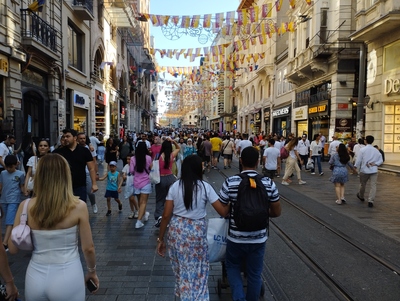
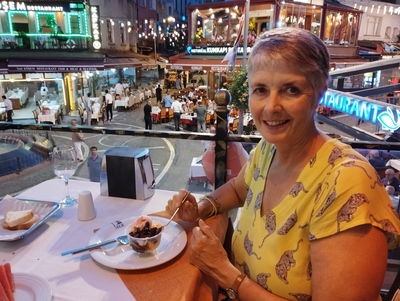
Istanbul has an odd and complex geography. The city is built on either side of the Bosphorus Strait, a broad waterway that connects the Sea of Marmara to the south with the almost-landlocked Black Sea to the north. Branching off to the left (west) of the Bosphorus Strait is an estuary called the Golden Horn which splits the western part of Istanbul into two. So there are three parts to Istanbul - the Asian part to the east of the Bosphorus and the two European parts north-east and south-west of the Golden Horn. Multiple bridges and tunnels connect all three sections of the city to each other, and there are also a great many ferries and pleasure boats that criss-cross the water at all hours of the day and night. The south-west end of the Sea of Marmara is linked to the Mediterranean Sea via another narrow channel called the Dardanelles Strait. Most of the tourist sights in Istanbul are in the eastern part of the (southern) European section, and that was where our hotel was located.
Trains to Istanbul from Asia terminate on the eastern side of the city. The grand old Haydarpasa Station was used for this for years, but it cannot accommodate modern high-speed trains. Instead our train from Ankara deposited us at Sögütlüçesme, a busy station with a convenient link to Istanbul's Metro. Unfortunately, despite the highly efficient integration of Istanbul's metro, tram and bus systems, buying a ticket to use the system (particularly if you cannot speak Turkish) is infernally difficult. Unlike the tram systems in Antalya and Konya, it appears that single tickets are not possible - you have to buy a multi-use card, called an Istanbulkart, for 50 Lira first. Then you have to load enough money onto the card to cover your journey. Simple enough, you say; but we could not find an automated machine that would dispense new Istanbulkarts anywhere. There were plenty of machines that would top up an existing card, but all of them had signs saying "No new cards." We watched the people using the machines and nobody bought a new card. So if you could only use the Metro with an Istanbulkart but you could not get an Istanbulkart, what were we supposed to do?
A guy at an information office understood, and pointed out of the building and round the corner. "Look for the yellow machines," he said. We went outside and found two machines craftily hidden out of sight behind a pillar. They were indeed yellow and they did, in theory at least, dispense new cards. There was a line of people waiting and we watched as those trying to use the machines cursed, shook their heads and hit the buttons with ever increasing force. Some walked away, muttering. One guy with two teenage children gave up at one machine then switched lines and tried the other. In the meantime we reached the front of the queue and began the baffling process of trying to buy an Istanbulkart ourselves. And it truly was baffling. You could choose English via a convoluted list of flags down the left, but it only applied to the first screen; as soon as you moved on to the next screen the machine reverted to Turkish. In addition to that, the fiendish people who designed the system had placed the machines out in the open, despite there being plenty of space under a shady overhang nearby. So it was extremely difficult even to make out what was on the screen in the glare of the sun. We managed to figure out how to select "Buy Istanbulkart" but the timeout period for putting your cash into the slot was only three seconds. Three seconds! We could not do it in time on our first few attempts. Then when we managed to co-ordinate ourselves sufficiently to push a 200 Lira note into the slot, the wretched machine would not take it. Everything we tried failed. And the error messages were indecipherable.
I noticed that the guy with the children at the machine next to us had succeeded in getting a card and had loaded it with credits. I stopped him as he was leaving and pleaded for help. He was sympathetic, and hit the screen in the right places while we watched. I bunged a 200 Lira note into the slot and watched in amazement as a bright red card dropped into the tray below. Then the guy took the card, held it over a scanner and pointed to the screen, where it said "Istanbulkart, credit 150 TL." We had our means of transport! I thanked the guy (who wasn't Turkish or any other nationality we could identify) and we headed back into the Metro station. A short ride under the Bosphorus Strait via the Marmara Tunnel brought us to Yenikapi, and from there it was about a kilometre on cobbled streets to Hotel Orkide. Our room was tiny, and across the narrow street, mere metres away, a row of apartment blocks stared back at us. Laundry hung listlessly from balconies in the muggy heat. Welcome to Istanbul.
[Aside: If we'd arrived in Istanbul a few months later we would have been able to ride the Metro to a stop about a block away from our hotel. An old and disused rail line along the shore of the Sea of Marmara was being rebuilt while we there, and this new service opened for passenger traffic on 26 February 2024. The line connects Yenikapi with Sirkeci, the historic main train station in the European part of Istanbul].
[Saturday 1 July : Istanbul] We weren't prepared for the crowds at the Blue Mosque, Hagia Sophia (or Aya Sofya) and the Basilica Cistern. The huge open spaces around these wondrous sights were swarming with tourists, both local and international, on this holiday weekend. At least we managed to get into the Blue Mosque before security guards started limiting the number of people allowed in. Türkiye's most famous mosque is indeed beautiful inside, the mosaics and intricate decorations a stunning display of Islamic religious art. When we came out of the Blue Mosque we tried to see the Hagia Sophia, but the line of people waiting to get in was so long that we didn't even find the end of it. The queue for the Basilica Cistern was just as bad.
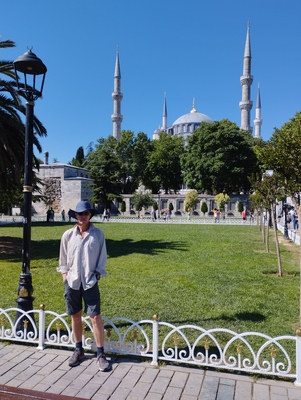

I hadn't been feeling well to start with, and the heat and crowds made it even worse. Karen had also been fighting a bug, so we gave up on the long queues and went back to our hotel for a nap. By late afternoon we were both feeling sufficiently better to take the tram through the Sultanahmet district and over the Galata Bridge to the Karaköy district on the northern side of the Golden Horn. Then we rode the funicular up through the mountain to the Beyoğlu district, where we walked round the corner to the vintage tram that crawls up the remainder of the hill to Republic Square at the top of Taksim. Crowds of people were everywhere, strolling, talking, eating ice cream (a favourite Turkish pastime), shovelling kebabs down their necks, drinking tea and generally having a good time. The streets were so congested with pedestrians that cars could hardly get past. An unusual sight was a large Christian church which seemed to be getting a lot of visitors. We went inside and discovered that it was St Anthony's Catholic Church, dating back to 1725 and still functioning. There were several Holy Masses on Sunday in a variety of languages, including Polish. Very odd - there must be a significant Polish-speaking population in Istanbul, as well as a priest who can speak Polish.
We walked back down the hill to Galata Bridge then over the Golden Horn on the bridge's lower pedestrian walkway. The bridge is lined with restaurants, each of which had a tout stationed outside who tried to entice us in. We looked at a few menus and were aghast at the prices. This was clearly Tourist Central, where a simple kebab was a few hundred Lira and coffee was routinely over 100 Lira. Across the bridge the trams were so packed with people that it was pointless even trying to get in. But the Istanbul public transport system is nothing if not efficient and responsive; we saw several relatively empty trams arrive at the station from one direction, disgorge their passengers then reverse direction and go the other way to try and cope with the crowds. The result was that trams were backed up, one behind the other and only seconds apart, and the sheer volume of people waiting to board was handled very well.
We did, eventually, go to one of the tourist restaurants (but not on Galata Bridge) and it was a fairly dismal meal. They overcharged us and were unpleasant when I queried the bill. A far cry from the superb food and friendly service we always got at the local, family-run diners we'd been accustomed to frequenting.
[Sunday 2 July : Istanbul] Hagia Sophia (or Aya Sofya) is probably the second-most visited site in Istanbul after the Blue Mosque. This grand building started out as a Byzantine (Eastern Orthodox) Cathedral in 537 AD, was taken over the by the Crusaders in 1204 and then became a mosque when Ottoman forces gained control of Constantinople in 1453. It remained a mosque until after Türkiye became an independent republic. In 1935 Mustafa Kemal, Türkiye's first president, decreed that the Hagia Sophia should be converted to a museum. But in 2020 the government reversed that decision and the Hagia Sophia became a mosque again, a move that was condemned by opposition parties in Türkiye as well as by the international community.

In order to beat the crowds, we were outside the Hagia Sophia shortly after 8 am. I'd tried to find out when it opened, but all I could establish was that it was "open 24 hours a day." That didn't seem likely, and it wasn't - 24 hour access only applied to Muslim worshippers, not tourists. But we only found that out when we got there, and had to wait behind some barricades until 9 am. At least it wasn't searingly hot yet. By the time the barricades were opened the line of people waiting to get in snaked around the square and doubled back on itself. The wait was worth it though - the inside of the Hagia Sophia was indeed impressive. Unfortunately, after becoming a mosque again, much of the interior was cordoned off to visitors and we were unable to see many of the building's highlights that were listed in our guidebook. We did, however, see the 10th century mosaic depicting Constantine the Great, Emperor Justinian and the Virgin Mary holding the Christ Child. This famous mosaic is on an upper wall and is freely available for everybody to look at, for the simple reason that it is Christian, not Muslim.
Next stop was Topkapi Palace. There were no queues of people waiting to get in, for the simple reason that the palace and its grounds are so enormous that there is no need to limit numbers. But the cost to see this monument to centuries of draconian rule by Turkish Sultans left us shaken - 750 Lira each just to get inside and another 200 Lira to visit the Harem. In fact, the combined ticket's 950 Lira price was a stick-on piece of paper, and when I looked closely I could see the original price of 420 Lira underneath it. So the greedy swines had more than doubled the entrance fee quite recently! I suppose you could argue that the price increase was justified because there were still massive crowds flocking in to visit the palace. Certainly there was no sign that the steep entrance fee was putting people off.
Was it worth it? In hindsight, perhaps not ... the palace is vast, with rooms, courtyards, chambers, pavilions and terraces that seem to go on for ever. The Harem, rather than being the area where the Sultan housed his bevy of loose women, was where all the women of the court lived. This included the Sultan's wives, daughters, their attendant maids and all of his concubines, plus the eunuchs who looked after the lot of them (or kept them in line, depending on your point of view). But it was just a rambling collection of rooms and not overly interesting. No loose women at all were in evidence (unless you count the Western girls in their tight shorts and skimpy tops).

[Monday 3 July : Istanbul] Our last day in Türkiye ... our flight back to South Africa was just after midnight so we had a whole day in Istanbul left. We had to check out of our hotel at 12 noon, but by dint of some smiling and pleading eyes Karen managed to persuade the guy at reception to let us stay until 4 pm.
We spent the morning at the Grand Bazaar, a centuries-old market that carries with it a reputation for thievery, skulduggery and relentlessly persistent carpet salesmen. But, in fact, it was nothing like that. The Grand Bazaar is just a very old shopping mall, no different from shopping malls the world over except that it isn't modern and glitzy. There are multiple corridors and passages, most of them narrow, and we got hopelessly lost several times. I kept waiting for carpet salesmen to pop out of their shops and try to entice us in for tea (and a carpet), but it never happened. Nobody seemed interested in us. Perhaps we looked too travel-weary and weatherbeaten after four weeks in Türkiye? We exited the Grand Bazaar and retired to a diner on the street outside, where we enjoyed an excellent vegetarian meal cooked on the spot by a bevy of smiling ladies.
We rested up at our hotel before embarking on the long journey to Istanbul's new (and distant) airport. First was the fifteen minute walk to Yenikapi station, where we caught a train on the M2 Metro line to Sisli-Mecidiyeköy. There we changed to the M7 Metro line and got off at Kagithane. The Istanbul Metro map indicated that we should change trains at Kagithane to the M11 Metro line, but try as we might we could find no signage for how to do this. Eventually a helpful Turkish woman explained that we had to exit the station, cross the road and walk a couple of hundred metres to another station, also named Kagithane. None of this was obvious, but after some confusion in the hot sun we found the entrance to the new underground line to the airport. Down we went, and boarded a train that swept through dark tunnels for many kilometres before arriving at Havalimani airport. The whole journey from our hotel took more than two hours!
We both used the same Istanbulkart to enter and exit the stations, and I was worried that we wouldn't have enough credit on it for the long trip to the airport. But every turnstile worked so we'd obviously calculated the cost correctly. After we'd exited the airport station I put the card into one of the recharge machines to check the balance and saw that there was only 1.92 Lira left. 1.92! We really cut it fine ...
From the airport station we still had to ascend five or six levels of escalator before finally finding ourselves in a wide walkway leading into the airport. Check-in, passport control and an absurdly overpriced coffee were our last memories of a fantastic holiday. It was crowded, it was hot, it was tiring, but we enjoyed ourselves thoroughly. Thank you Türkiye!
[Tuesday 4 July 2023 : Cape Town, South Africa] And then we were home ... Next stop Japan in 2024!